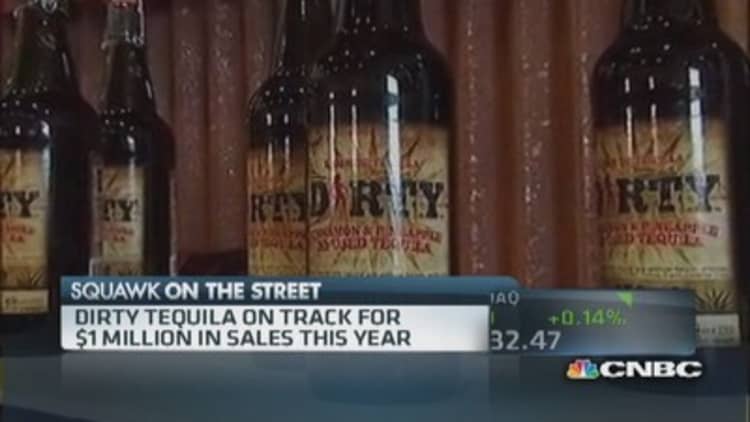"We're 100 calories, we're 8 percent alcohol by volume, and we're an adult freezer pop," Phil Hurley said as he prepared to slurp on a frozen Slim Chillers watermelon martini pushed out of a plastic tube. Hurley's trademarked the phrase "Freeze your a-- off," and his line of beverages did nearly a quarter million dollars in sales in its first year.
Low-calorie, premixed frozen cocktails are just one sign that millennials are looking for a new kind of happy hour.

Cocktail gels, infused tequila, and craft beer—lots and lots of craft beer—are being highlighted in Las Vegas this week at the Nightclub & Bar Show. Bar and club managers who would normally be sampling the competition on the Vegas Strip are spending three days inside the convention center attending sessions on everything from carbonated cocktails to the best ways to price high-end drinks. (Hint: don't price them too high or no one will buy them.) These people are part of an industry that sells an estimated $20 billion in booze.
"The customer is more educated," Brian Warrener, a professor of hospitalities management at Johnson & Wales University, told a group of bar managers. "You need to be more educated."
An estimated 37,000 professionals are in Sin City to become more educated about the bar business, a 30 percent jump in attendance from a year ago, according to Jon Taffer, who runs the show when he's not hosting "Bar Rescue" on Spike TV.
The convention added another 25,000 square feet this year, and the Bud Light Hotel is making its first appearance, as beer giants like Anheuser-Busch InBev and MillerCoors work to maintain dominance. "There's a lot of competition out there," said Dan Parr, MillerCoors' chain sales manager for the Pacific region.
Beer v. spirits
Research by Nomura suggests spirits are gaining share in the overall alcohol market, taking nearly 35 percent of all alcohol revenue in the U.S. in 2013 and 33 percent of volume. But beer is fighting back with beer cocktails, ciders and products that are craft-like but mass produced.
MillerCoors is trying to ride the craft trend with Blue Moon, and Anheuser-Busch InBev has Shock Top. This month, Parr said, MillerCoors is launching its biggest product introduction ever with Miller Fortune, a beer with a higher alcohol content of 6.9 percent but less bitter than many of the craft brews.
"Really this product is geared toward the millennial consumers, 21- to 27-year-olds, that are looking to extend their night a little bit," he said. "They've been going kind of hard all night, and they want to peel it back a little bit and relax."
Anheuser-Busch InBev is entering the cider market next month with Johnny Appleseed Hard Apple Cider, and the beer giant "is getting feisty," according to RBC Capital Markets. "2014 is the year when Anheuser-Busch InBev has decided on a proper swing of the bat."
It needs a home run. While Bud Light alone still has triple the sales volume of the entire craft industry combined, craft sales are growing much faster. Some wonder, however, if too many players are making craft beer and beginning to hurt the industry with increasingly "hoppy" or bitter brews.
"Some of the products are not as good as others," said Taffer. "I could take a cemetery and make all the tombstones beer companies. There's a lot of craft beers that came and went. A lot of them."
Attendee Kevin Kruse, who manages the Wills Northwoods Inn in Chicago, wonders about the craze over IPAs. "I do think it's coming to an end at some point," he said, "but then the next thing will be waiting."
Cocktails
Then there's the craft cocktail craze. "The word 'mixology' adds $3 to the price of any drink," said Taffer. "People are resisting that now. They're starting to push back."
Research by Technomic suggests Americans are starting to spend less on booze at bars and restaurants, which means pricing premium cocktails appropriately can be tricky.
"The new reality is that everything costs more. The new reality is your customers demand premium products," said Warrener. "Just the way it is."
He spoke to a standing-room-only crowd about the best ways to price beverages, counseling bar managers to lower profit margins for higher priced drinks in order to encourage consumers to trade up. "People are going to say, 'I appreciate that that's a really fine product, but I'm not willing to pay $17 to drink it.'"
Expensive spirits, fresh squeezed juices, a dizzying array of beers to choose from, it can be overwhelming for a bar manager trying to find the right mix. Taffer said the biggest mistake an owner can make, however, is to make excuses.
"In the worst of our recession, bars were making money," he said. "Every bar can make money. If they're failing, it's not because of the president or Congress or Ukraine. It's because of them. And if you own failure then you'll own success. Excuses destroy success every time."
—By CNBC's Jane Wells. Follow her on Twitter @janewells.




